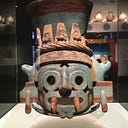Member-only story
The Archeotourist — 01
The Ballgame (Pok-ta-pok) and the Maya
Our understanding of the ballgame comes from three sources: firsthand accounts — both from Spanish and indigenous accounts of Aztec ballgames, the account of the ballgame of the Hero Twins with the Lords of Death in the Popul Vuh, and what archeology — both in excavated ballcourts and artifacts like the vase above, tells us. Let’s look at what each of these sources can tell us.
Firsthand accounts:
When they landed in the New World, the Spanish had never seen a ballgame like this, let alone a rubber ball. The Europeans were so intrigued, they sent a team of indigenous players to Spain to show the game to Charles V who, it’s recorded, was delighted at the spectacle.
That is all we know about these men who were shipped to Spain like exotic animals to perform for their new overlord. We don’t know their names. We don’t know if they volunteered to make the journey or if they were slaves. Perhaps they thought that after they played the game for their captors they would be ritually sacrificed. A fate that was not uncommon for war captives in Aztec culture.
